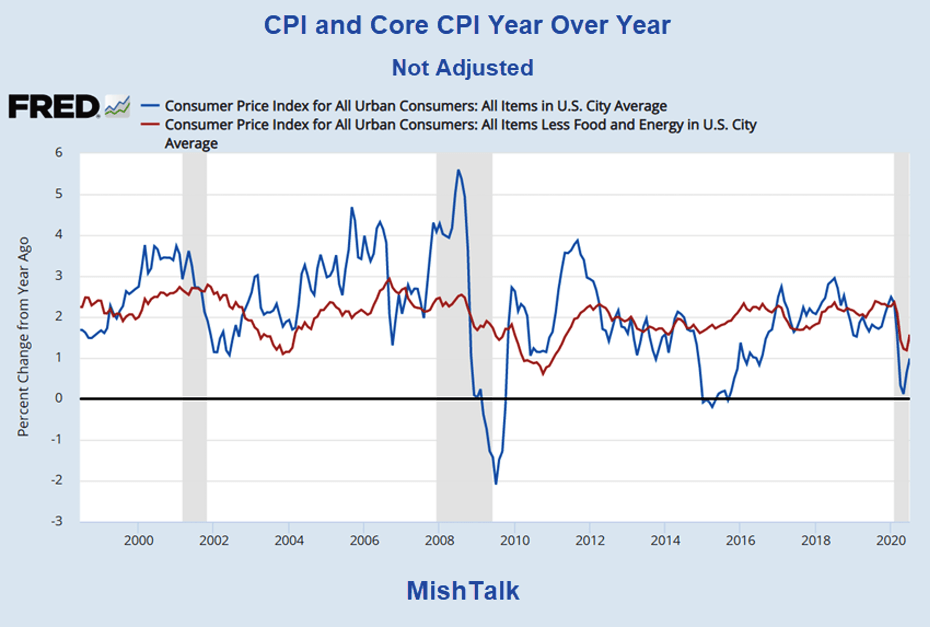The CPI and the core CPI (excluding food and energy) both jumped 0.6% in July from June.
Core CPI up most since january 1991
The BLS CPI Report shows another sharp month-over-month rise, but year-over-year is another matter.
CPI month-over month
- The Consumer Price Index for All Urban Consumers (CPI-U) increased 0.6 percent in July on a seasonally adjusted basis, the same increase as in June.
- The gasoline index continued to rise in July after increasing sharply in June and accounted for about one quarter of the monthly increase in the seasonally adjusted all items index.
- The energy index increased 2.5 percent in July as the gasoline index rose 5.6 percent.
- The food index decreased 0.4 percent in July, with the index for food at home declining 1.1 percent.
- The index for all items less food and energy rose 0.6 percent in July, its largest increase since January 1991.
- The index for motor vehicle insurance increased sharply in July, as it did the previous month. The indexes for shelter, communication, used cars and trucks, and medical care also increased in July, while the index for recreation declined.
CPI year over-year
- The all items index increased 1.0 percent for the 12 months ending July, a larger increase than the 0.6- percent rise for the period ending June.
- The index for all items less food and energy increased 1.6 percent over the last 12 months.
- The food index increased 4.1 percent over the last 12 months, with the index for food at home rising 4.6 percent.
- Despite increasing in July, the energy index fell 11.2 percent over the last 12 months.
Word about measurement from the BLS
Data collection by personal visit for the Consumer Price Index (CPI) program has been suspended since March 16, 2020. When possible, data normally collected by personal visit were collected either online or by phone. Additionally, data collection in July was affected by the temporary closing or limited operations of certain types of establishments. These factors resulted in an increase in the number of prices considered temporarily unavailable and imputed. While the CPI program attempted to collect as much data as possible, many indexes are based on smaller amounts of collected prices than usual, and a small number of indexes that are normally published were not published this month.
Poor measure of inflation
These indexes supposedly measure inflation.
They do nothing of the kind. The indexes do not include home prices, only rent.
The purported medical inflation is a joke. Anyone who buys their own medical insurance will tell you their costs are up more than the reported 5.9%.
Anyone in college has not been pleased with the rising cost of tuition and rent in college towns.
And anyone with an ounce of common sense knows the current stock market bubble is a measure of inflation.
Focus on consumer inflation is horribly wrong
Stock prices are not "consumer" inflation, but realistically home prices are.
Regardless, the Fed's focus on consumer inflation ignoring housing, while averaging medical costs with those on company plans and Medicare is just plain wrong.
Central banks’ seriously misguided attempts to defeat routine consumer price deflation is what fuels the destructive asset bubbles that eventually collapse
Fed can blame itself
I am not blaming the Fed for the coronavirus and these shocks.
However, I am blaming the Fed for its erroneous inflationary tactics that blew three of the biggest economic bubble in succession: 2000, 2007, 2020.
This material is based upon information that Sitka Pacific Capital Management considers reliable and endeavors to keep current, Sitka Pacific Capital Management does not assure that this material is accurate, current or complete, and it should not be relied upon as such.
Recommended Content
Editors’ Picks
EUR/USD holds above 1.0700 ahead of key US data

EUR/USD trades in a tight range above 1.0700 in the early European session on Friday. The US Dollar struggles to gather strength ahead of key PCE Price Index data, the Fed's preferred gauge of inflation, and helps the pair hold its ground.
USD/JPY stays above 156.00 after BoJ Governor Ueda's comments

USD/JPY holds above 156.00 after surging above this level with the initial reaction to the Bank of Japan's decision to leave the policy settings unchanged. BoJ Governor said weak Yen was not impacting prices but added that they will watch FX developments closely.
Gold price oscillates in a range as the focus remains glued to the US PCE Price Index

Gold price struggles to attract any meaningful buyers amid the emergence of fresh USD buying. Bets that the Fed will keep rates higher for longer amid sticky inflation help revive the USD demand.
Sei Price Prediction: SEI is in the zone of interest after a 10% leap

Sei price has been in recovery mode for almost ten days now, following a fall of almost 65% beginning in mid-March. While the SEI bulls continue to show strength, the uptrend could prove premature as massive bearish sentiment hovers above the altcoin’s price.
US core PCE inflation set to signal firm price pressures as markets delay Federal Reserve rate cut bets

The core PCE Price Index, which excludes volatile food and energy prices, is seen as the more influential measure of inflation in terms of Fed positioning. The index is forecast to rise 0.3% on a monthly basis in March, matching February’s increase.

